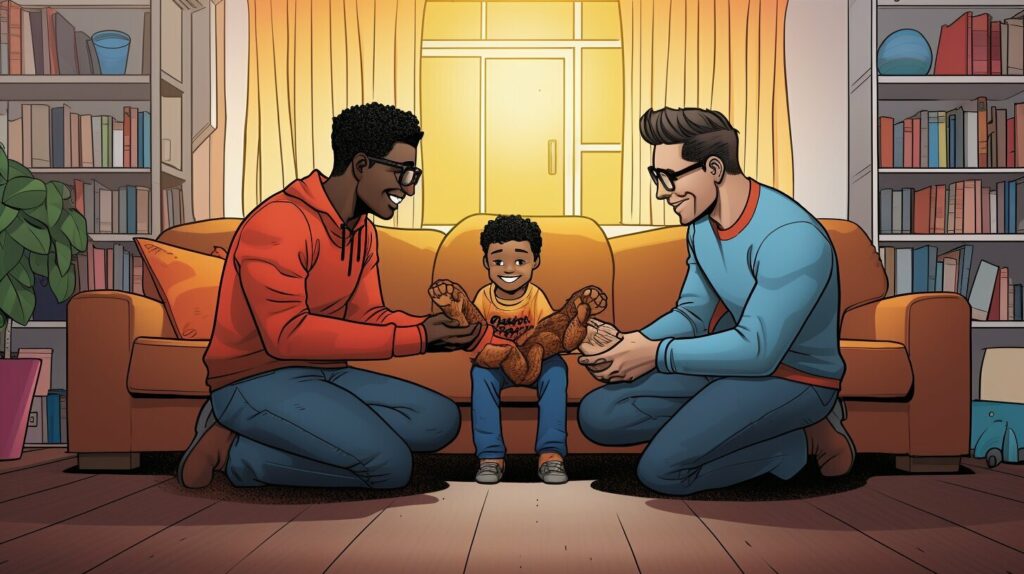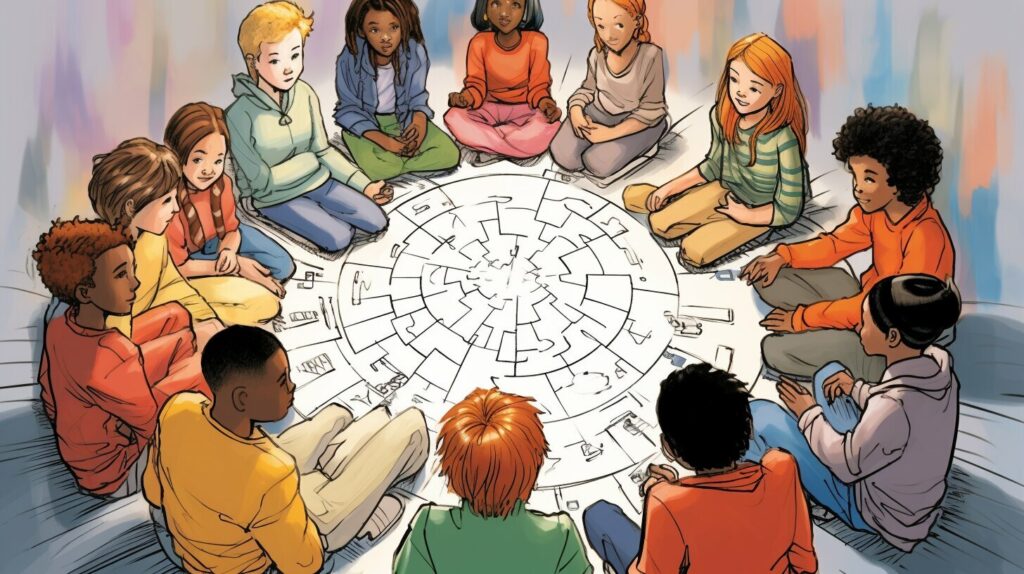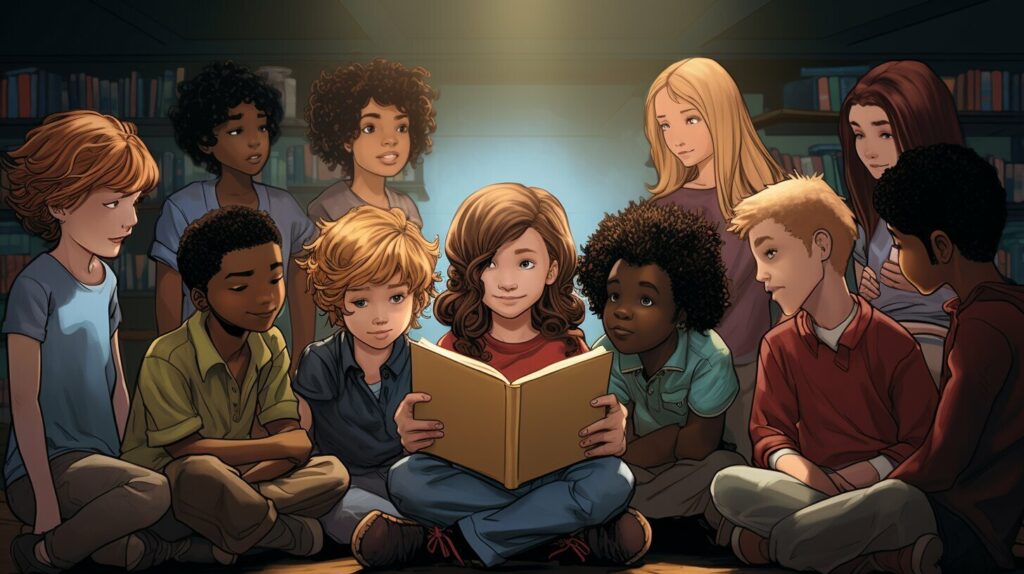
Understanding Divorce: How to Explain Divorce to a Child
Understanding divorce and finding the right words to explain it to a child can be challenging, but with compassion and clear communication, you can help your little one navigate this significant life change. It’s important to consider your child’s age and developmental stage, as well as provide a supportive and reassuring environment throughout the process.
In this article, we’ll provide guidance on talking to your child about divorce, including age-appropriate explanations and tips for supporting their emotional well-being. By prioritizing your child’s needs and maintaining open communication, you can help them understand and cope with divorce in a healthy way.
Key Takeaways:
- When explaining divorce to young children (ages 0-5), provide simple and concrete explanations that take into account their developmental stage and need for stability.
- Preschoolers may struggle to understand the causes and effects of divorce, but reassuring them that they will still be cared for is essential.
- Children aged 6-11 may struggle with assigning blame or black-and-white thinking, so providing clear and age-appropriate information is crucial.
- Engaging preteens (ages 12-14) in discussions about the divorce can increase their understanding and involvement, as well as promote open communication.
- Listening to and supporting your child’s emotional reactions is important, as is avoiding blame and maintaining a working relationship with your ex-spouse to reduce stress.
Understanding Divorce for Younger Children (Ages 0-5)
When explaining divorce to younger children (ages 0-5), it’s important to consider their developmental stage and provide simple, concrete explanations. Young children may struggle to understand complex concepts, so it’s important to explain the separation in clear and straightforward language.
Provide simple explanations that focus on basic changes, such as where the child will live and who will take care of them. Avoid using terms such as “separation” or “divorce” that may be confusing and abstract for young children to understand.
Preschoolers may not understand the causes and effects of divorce, but they may worry about how it will affect their daily routine and their relationship with their parents. It’s important to emphasize that the separation is an adult decision and reassure them that they will still be cared for and loved by both parents.
Maintaining stability and routine is crucial for young children, as they rely on it for a sense of security. Try to maintain regular schedules for meals, naps, and playtime as much as possible.
Supporting Preschoolers Through Divorce
Preschoolers may struggle to understand the causes and effects of divorce, so it’s important to emphasize that it is an adult decision and reassure them that they will still be cared for. Providing simple, concrete explanations that they can understand is key. Avoiding complex legal or financial details is recommended, as this may cause confusion or anxiety.
Preschoolers may worry about changes to their daily routines or living arrangements. Maintaining stability as much as possible, such as keeping consistent schedules for meals, naps, and bedtime, can help alleviate their concerns. It’s also important to assure them that both parents love them and will still be involved in their lives.
| Do: | Don’t: |
|---|---|
| Provide simple, concrete explanations. | Use complex legal or financial details. |
| Reassure them that they will still be cared for and loved. | Blame the other parent or speak negatively about them. |
| Maintain stability and routine as much as possible. | Make promises that cannot be kept. |
Additionally, it is important to address any questions or concerns that preschoolers may have, even if they may seem trivial or repetitive. Listening to their feelings and validating them can help them feel heard and supported. Encouraging them to express their emotions through play, art, or other methods can also be helpful.
Overall, supporting preschoolers through divorce involves providing simple, concrete explanations, reassuring them of their importance and love, maintaining stability and routine, addressing their questions and concerns, and promoting open communication.
Talking to Children Ages 6-11: Providing Age-Appropriate Information
When talking to children between the ages of 6 to 11, their ability to understand and talk about feelings and circumstances related to divorce improves. However, they may still struggle with black-and-white thinking and assigning blame. It’s important to provide clear and age-appropriate information, avoiding financial settlements or negative statements about the other parent.
Children in this age group may ask detailed questions about the divorce process, the reasons for the separation, and the future living arrangements. It is important to provide truthful, yet simple answers that focus on reassurance and stability. Avoid using language that places blame or portrays one parent as the “bad guy”.
It can be helpful to explain that the decision to divorce is an adult decision and that it does not change the amount of love that each parent has for the child. Children should be reminded that they are not responsible for the divorce and that both parents will continue to be a part of their lives, even if living in separate homes.
Listening to their concerns and reassuring them that the divorce is not their fault is essential. Children may feel a range of emotions such as sadness, anger, or anxiety. Acknowledging their feelings and encouraging them to express themselves can help them work through their emotions.
Overall, providing age-appropriate and clear information, avoiding blaming language, and reassuring children of their importance and love can help children in this age group understand and adjust to the changes resulting from divorce.
Addressing Concerns and Blame
It’s important to provide clear and age-appropriate information when talking to children about divorce, especially those between the ages of 6 to 11. While they are more able to understand the concept of divorce, they may still struggle with black-and-white thinking and assigning blame.
It’s crucial to avoid negative statements about the other parent and providing financial settlements to the child. Instead, focus on providing clear and honest information about what is happening and what changes might occur. Listen to their concerns and reassure them that the divorce is not their fault, emphasizing that they are still loved and cared for.
Reassurance is essential to helping children feel secure and supported through a difficult time. Let them know that they can express their emotions and that their feelings are valid. Encourage them to ask questions and provide age-appropriate answers that address any concerns they may have.
It’s also important to avoid blaming each other and instead focus on the child’s well-being. Children need stability and routine, and maintaining this as much as possible can provide a sense of security during a time of change.
Overall, by providing clear and honest information, avoiding negative statements about the other parent or financial settlements, and reassuring children that they are not at fault for the divorce, we can alleviate their concerns and support them through this difficult time.
Engaging with Preteens (Ages 12-14)
For children aged 12 to 14, their capacity to understand divorce-related issues increases, and they may want to be more independent and question parental authority. It is important to engage them in discussions about the divorce and answer their questions truthfully. Pretend that they are adults and don’t talk down to them.
At this age, preteens may have an increased need for privacy and personal space. It’s important to respect their boundaries while maintaining open communication. Encouraging them to express their feelings and concerns can help them feel heard and understood. It’s essential to listen to their questions and concerns without becoming defensive or dismissive.
Preteens may also show signs of emotional distress or act out in response to the divorce. It’s important to support them and offer resources such as therapy or support groups if needed. By being available and responsive, you can help your child navigate this difficult time and emerge with a sense of resilience and strength.
“I know it’s hard to talk about the divorce, but I want you to know that I’m here for you. If you have any questions or concerns, I’m ready to listen.”
Talking to Children Ages 6-11: Providing Age-Appropriate Information
Engaging them in discussions and answering their questions can increase their understanding and involvement. Children between the ages of 6 and 11 have a better ability to understand and talk about the circumstances and feelings related to divorce. However, they may still struggle with black-and-white thinking and assigning blame. It’s important to provide clear and age-appropriate information about the reasons for the divorce, avoiding financial settlements or negative statements about the other parent.
When talking to children in this age group, it’s important to listen to their concerns and reassure them that the divorce is not their fault. Expressing your continued love for them and addressing potential changes can help ease their anxiety and provide them with a sense of stability. It’s important to maintain open communication and to avoid blaming each other, as that can make children feel caught in the middle.
Children in this age group may struggle with feelings of confusion, sadness, or anger about the situation. Answering their questions and providing them with age-appropriate information can help them better understand what is happening. It’s important to empathize with their emotions, listen actively, and acknowledge their feelings. Reassuring them that they are loved and valued is vital in helping them cope with the changes that come with divorce.
Essential Tips for Explaining Divorce to Children
When explaining divorce to children, it is recommended to plan out what you want to say beforehand. This will help ensure that the conversation is clear, honest, and age-appropriate. Both parents should ideally be present during the conversation to demonstrate unity and reassurance. This can help ease the child’s anxiety and prevent confusion about the situation.
Providing a simple and honest explanation is essential when talking to children about divorce. Explain the situation in terms that they can understand, and avoid complicated legal or financial terms. It’s important to express continued love for the child and reassure them that the divorce is not their fault.
It’s crucial to avoid blaming each other and to focus on the child’s well-being. The conversation should be centered around the child, and not the reasons for the divorce. Keep the conversation positive, and avoid speaking negatively about the other parent.
Addressing potential changes is essential when explaining divorce to children. Inform them of any changes that may occur, such as changes in living arrangements or schedules. Be honest about any potential disruptions to their routine, but also reassure them that they will still be cared for.
By planning the conversation, having both parents present, and providing a simple and honest explanation, you can help make the conversation about divorce easier for your child. Remember to keep the conversation centered around the child, and to prioritize their well-being throughout the divorce process.
Supporting Children’s Emotional Reactions
Children may have various reactions to the news of divorce, including relief, anger, guilt, or fear about the future. It is crucial to listen to their feelings and concerns carefully, and validate their emotions. As a parent, it’s important to provide support and empathy, encouraging them to express themselves and process their feelings.
Children may feel a range of emotions following the news of divorce, and it’s important to acknowledge and validate their emotions. Listening with empathy and providing reassurance can help them feel more secure and supported throughout the process. Even though it may be difficult to hear, allow your child to express their feelings and concerns without judgment or criticism. Encourage honesty, and let them know that it’s okay to feel a range of emotions.
In addition, it’s important to reassure children that they are still loved and will continue to be cared for, despite the changes. Continuously remind them that the divorce is not their fault and that both parents will still be present in their lives. Providing a safe and supportive environment for them to express their feelings and concerns can help ease their emotional distress.
It’s crucial to keep in mind that children may struggle with processing and expressing their emotions effectively. Encouraging them to engage in activities that they find enjoyable can be helpful in managing their emotional reactions. For example, physical exercise, creative activities, or spending time with loved ones.
Overall, being present for your child, listening to their feelings and concerns, providing reassurance, and promoting self-care can help children manage their emotional reactions to divorce. Assuring them of their importance and love, and providing information and support as needed, can also help them feel more secure throughout the process.
“Listening with empathy and providing reassurance can help them feel more secure and supported throughout the process.”
Maintaining Positive Relationships with the Ex-Spouse
It is important to listen to their feelings and concerns, assure them of their importance and love, and provide information and support as needed. Additionally, maintaining a working relationship with the ex-spouse can significantly reduce stress for the children.
While it may be challenging, working towards a positive relationship with the ex-spouse can have a profound impact on the children. It can reduce conflict and create a more stable environment for the children, which can help them adjust to the changes caused by the divorce.
It’s important to communicate with the ex-spouse in a respectful and constructive way, focusing on what’s best for the children. Avoid using the children as messengers or using them to gather information about the ex-spouse. Instead, work on finding common ground and collaborating in co-parenting responsibilities.
Remember that maintaining a positive relationship with the ex-spouse doesn’t mean you have to be close friends or spend time together. It simply means working together in a civil and respectful manner for the well-being of your children.
By prioritizing your children’s needs and maintaining a positive relationship with your ex-spouse, you can help reduce stress and create a more stable environment for them during this difficult time.
Prioritizing Children’s Well-Being Throughout the Divorce Process
Overall, helping children through divorce involves prioritizing their well-being, maintaining stability and routines, providing age-appropriate information, supporting their emotions, and assuring them that they are not at fault for the divorce. However, ensuring children’s well-being throughout the divorce process requires open communication, empathy, and reassurance.
Despite the emotional stress and turmoil that may arise, taking the time to communicate with children and listen to their concerns is crucial. Open communication can help alleviate their anxieties and provide them with a sense of security during this challenging time.
Empathy is another important component in helping children navigate divorce. Children may react differently to divorce and may experience a range of emotions, from sadness to anger or confusion. Acknowledging and validating their feelings can help them process their emotions and move forward in a healthy manner.
Reassurance is also essential in this process. Children may blame themselves for the divorce, and it is important to let them know that their parents’ separation is not their fault. Expressing continued love and support is crucial and can help reassure them that they will still be cared for.
Maintaining routines and stability is also important for children, as they rely on consistency for a sense of security. Providing a consistent routine and maintaining stability can help children adapt to the changes and minimize the negative impact of the divorce.
Overall, prioritizing children’s well-being throughout the divorce process involves open communication, empathy, reassurance, and maintaining stability. By considering children’s feelings and needs, parents can help children navigate the process of divorce in a healthy and positive way.
Conclusion
By approaching the topic of divorce with sensitivity and providing age-appropriate explanations, you can help your child understand and navigate this significant life change. Remember to prioritize their well-being, maintain stability and routines, and provide reassurance throughout the process. It’s important to listen to their concerns, avoid blaming each other, and maintain a working relationship with the ex-spouse to reduce stress for the children.
Remember to plan out what you want to say beforehand, have both parents present during the conversation, and provide a simple and honest explanation. For younger children (ages 0-5), provide simple, concrete explanations and emphasize reassurance and stability. With children between the ages of 6 to 11, provide clear and age-appropriate information, and listen to their concerns. For children aged 12 to 14, engage them in discussions, answer their questions, and avoid speaking negatively about the other parent.
Understanding Divorce: How to Explain Divorce to a Child is an important topic that requires careful communication. By being open, empathetic, and reassuring, you can help your child navigate this difficult time and come out on the other side with a sense of security and stability.
FAQ
Q: How do I explain divorce to a young child (ages 0-5)?
A: When explaining divorce to young children, it’s important to keep it simple and concrete. Emphasize that it is an adult decision and reassure them that they will still be cared for.
Q: What can I do to support preschool-age children through divorce?
A: Reassurance and maintaining stability are key for preschoolers. Focus on maintaining routines and providing a sense of security.
Q: How do I talk to children ages 6-11 about divorce?
A: Provide age-appropriate information and avoid assigning blame. Listen to their concerns and reassure them that the divorce is not their fault.
Q: How can I engage preteens (ages 12-14) in conversations about divorce?
A: Engage them in discussions, answer their questions, and promote open communication. Address their concerns and avoid speaking negatively about the other parent.
Q: What are some essential tips for explaining divorce to children?
A: Plan out what you want to say beforehand. Ideally, both parents should be present during the conversation. Provide a simple and honest explanation, express continued love for the child, and address potential changes.
Q: How can I support children’s emotional reactions to divorce?
A: Listen to their feelings and concerns, assure them of their importance and love, and provide information and support as needed.
Q: How important is maintaining a positive relationship with the ex-spouse?
A: Maintaining a working relationship with the ex-spouse can significantly reduce stress for the children.
Q: What should be prioritized when helping children understand divorce?
A: Prioritize their well-being, maintain open communication, and provide reassurance that the divorce is not their fault.
- Exploring Why Peanut Allergies Are So Common Today - January 18, 2024
- Curious Facts: Why is it Called Bollywood? - January 17, 2024
- Unveiling the Secret: Why is it Called Moonshine? - January 13, 2024






